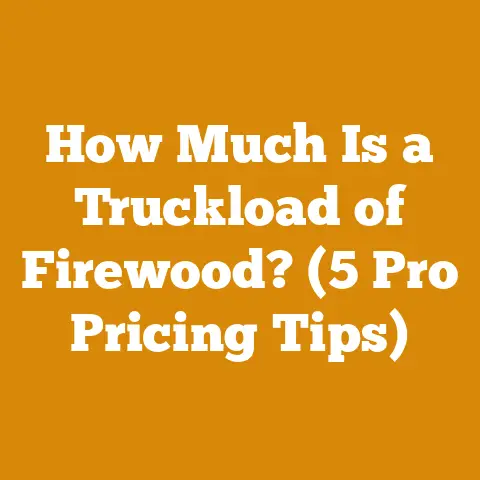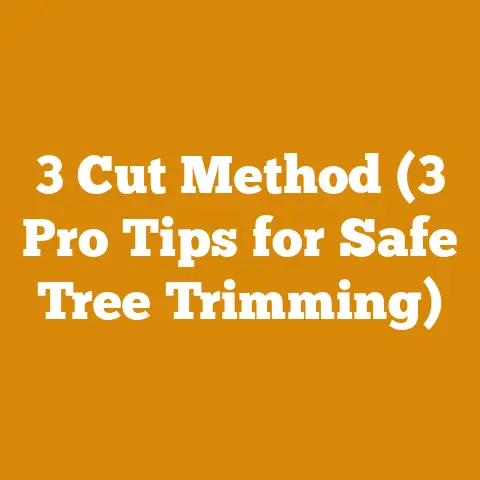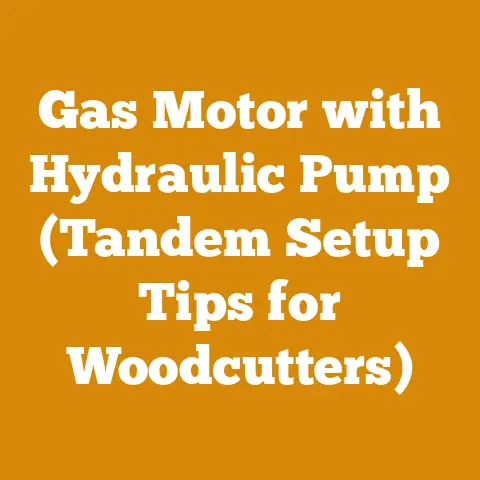Wood Stove Insert for Prefab Fireplaces (5 Safety Tips Pros Use)
It’s Sunday morning, the smell of coffee fills the air, and I’m already thinking about my next woodworking project.
Maybe it’s building a new bookshelf, or perhaps finally getting around to crafting that custom headboard I’ve been dreaming about.
But, before any of that can happen, I need to ensure my workshop is ready for the winter months.
That means making sure my heating is sorted.
Now, I love the ambiance of a crackling fire, but the open fireplace in my living room?
It’s more of a heat escape route than a heat source.
That’s where the idea of a wood stove insert comes in, specifically one designed for a prefabricated fireplace.
But, here’s the thing: safety first.
And while I’m handy with a chisel and a saw, I’m no expert on fireplace inserts.
So, I’ve been digging deep, researching the ins and outs of installing a wood stove insert in a prefab fireplace, focusing on safety.
I’m talking meticulous research, consulting with pros, and learning from their experiences.
And now, I’m ready to share what I’ve learned with you.
Wood Stove Insert for Prefab Fireplaces: 5 Safety Tips Pros Use (and a Cost Breakdown)
The allure of a wood-burning stove insert in a prefabricated fireplace is undeniable.
It promises increased heating efficiency, a beautiful focal point for your living space, and the cozy ambiance of a real fire.
But, before you rush out and buy the first insert you see, it’s crucial to understand the safety considerations and the associated costs.
Many homeowners, like myself, find themselves in older homes with existing prefabricated fireplaces.
These fireplaces, while aesthetically pleasing, often lack the heating efficiency of modern wood stoves.
A wood stove insert offers a solution, but it’s a solution that demands careful planning and execution.
Why Prefab Fireplaces Need Special Attention
Prefabricated fireplaces are different from traditional masonry fireplaces.
They are typically lighter, made of metal components, and designed to radiate heat differently.
They are engineered and tested as a complete system.
Therefore, slapping just any wood stove insert into a prefab fireplace is a recipe for disaster.
This is because prefab fireplaces are specifically designed to handle the heat output of the original firebox they were installed with.
Introducing a higher heat source, like a wood stove insert not specifically designed for the unit, can lead to overheating, structural damage, and even house fires.
That’s why I’ve compiled these safety tips, learned from experienced professionals, to guide you through the process.
Tip #1: Verification and Compatibility: The Golden Rule
This is the most critical step.
Never assume that a wood stove insert is compatible with your prefabricated fireplace.
Before you even think about purchasing an insert, you must verify its compatibility with your specific fireplace model.
- Check the Fireplace’s Listing: Your prefabricated fireplace should have a listing label, often found on the firebox or behind a metal plate on the side.
This label contains crucial information, including the manufacturer, model number, and listing standards (e.g., UL 127, ULC S610). - Consult the Insert Manufacturer: Once you have your fireplace’s model number, contact the wood stove insert manufacturer.
Provide them with your fireplace’s information and ask if their insert is listed for use in your specific prefab fireplace.
They will be able to provide you with documentation proving compatibility. - Listed vs.
Approved: Don’t confuse “listed” with “approved.” A “listed” insert has been tested by a recognized testing laboratory (like UL or ETL) to meet specific safety standards.
However, it’s only “approved” for use with your fireplace if the manufacturer explicitly states its compatibility based on your fireplace’s listing. - Professional Consultation: When in doubt, consult with a certified chimney sweep or a qualified wood stove installer.
They can inspect your fireplace, verify its listing, and recommend compatible inserts.
Real-World Example: A friend of mine, thinking he was saving money, purchased a used wood stove insert online.
He figured, “It’s a wood stove, it’ll fit.” He nearly caused a house fire because the insert was not listed for use in his prefab fireplace.
The excessive heat warped the fireplace’s metal components, creating a dangerous situation.
Cost Implications: Skipping this step can lead to significant financial losses.
Installing an incompatible insert can void your homeowner’s insurance, damage your fireplace, and potentially require you to replace the entire fireplace system.
Data Point: According to the Chimney Safety Institute of America (CSIA), incompatible wood stove installations are a leading cause of chimney fires in the United States.
Tip #2: Flue Connection: The Lifeline of Your System
The flue (or chimney) is the lifeline of your wood-burning system.
It’s responsible for safely venting combustion gases out of your home.
A proper flue connection is essential for preventing carbon monoxide poisoning and chimney fires.
- Size Matters: The flue connector on the wood stove insert must match the size and type of the existing chimney system in your prefabricated fireplace.
Using the wrong size connector can restrict airflow, leading to incomplete combustion and the buildup of creosote. - Full Relining: In many cases, installing a wood stove insert into a prefabricated fireplace requires a full relining of the existing chimney with a stainless-steel liner.
This liner is specifically sized for the insert and provides a safe, continuous pathway for the exhaust gases. - Professional Installation: I strongly recommend hiring a professional to install the flue liner.
This is not a DIY project.
A professional will ensure that the liner is properly sized, insulated, and connected to both the insert and the chimney. - Insulation: Insulating the flue liner is crucial for maintaining proper draft and preventing creosote buildup.
Insulation helps keep the flue gases hot, which prevents condensation and promotes a strong, consistent draft.
Personal Experience: I once helped a neighbor install a wood stove in his garage.
He tried to cut corners by using a smaller-than-recommended flue pipe.
The result?
The stove smoked terribly, and the air quality in the garage was hazardous.
We had to redo the entire flue system, costing him more time and money in the long run.
Cost Breakdown:
- Stainless Steel Flue Liner (6-inch diameter, 25 feet): \$500 – \$1,000 (depending on quality and insulation)
- Professional Installation: \$500 – \$1,500 (depending on the complexity of the installation)
- Insulation: \$100 – \$300 (depending on the type of insulation)
Data Point: The National Fire Protection Association (NFPA) reports that creosote buildup in chimneys is a major cause of residential fires.
Tip #3: Clearances: Creating a Safe Zone
Wood stoves generate a significant amount of heat.
Maintaining proper clearances between the stove and combustible materials is essential for preventing fires.
- Manufacturer’s Specifications: Always follow the wood stove insert manufacturer’s clearance requirements.
These requirements are typically outlined in the owner’s manual. - Wall and Floor Protection: You may need to install additional wall and floor protection to reduce the risk of fire.
This protection can include non-combustible materials like brick, stone, or specially designed heat shields. - Corner Clearances: Pay special attention to corner clearances.
Corners tend to trap heat, so the clearance requirements are often greater in these areas. - Measure Twice, Cut Once: Before installing any wall or floor protection, carefully measure the distances between the stove and any combustible materials.
Double-check your measurements to ensure that you are meeting the manufacturer’s clearance requirements.
Case Study: A local homeowner ignored the clearance requirements when installing his wood stove insert.
He placed the stove too close to a wood-paneled wall.
Over time, the wall began to char, eventually leading to a fire.
Fortunately, the fire was contained, but it caused significant damage to the home.
Cost Considerations:
- Wall Protection (Brick or Stone): \$10 – \$30 per square foot (installed)
- Floor Protection (Non-Combustible Hearth Pad): \$200 – \$500 (depending on size and material)
- Heat Shields: \$100 – \$300 (per shield)
Data Point: The Consumer Product Safety Commission (CPSC) estimates that improper installation and maintenance of wood stoves contribute to thousands of residential fires each year.
Tip #4: Carbon Monoxide Detection: The Silent Guardian
Carbon monoxide (CO) is a colorless, odorless, and deadly gas produced by incomplete combustion.
Installing carbon monoxide detectors is essential for protecting your family from CO poisoning.
- Placement is Key: Install CO detectors on every level of your home, especially near sleeping areas.
- Regular Testing: Test your CO detectors regularly to ensure that they are functioning properly.
Replace the batteries at least once a year. - Know the Symptoms: Familiarize yourself with the symptoms of CO poisoning, which can include headaches, dizziness, nausea, and confusion.
- Professional Inspection: Have your wood stove and chimney inspected annually by a qualified professional to ensure that they are operating safely.
Personal Story: A few winters ago, my CO detector went off in the middle of the night.
I woke up feeling dizzy and nauseous.
I immediately evacuated my family from the house and called the fire department.
They discovered a blocked chimney flue, which was causing CO to back up into the house.
The CO detector saved our lives.
Cost Implication: CO detectors are relatively inexpensive, but they can save lives.
- Carbon Monoxide Detector: \$20 – \$50 (per detector)
Data Point: The Centers for Disease Control and Prevention (CDC) estimates that carbon monoxide poisoning causes hundreds of deaths and thousands of hospitalizations in the United States each year.
Tip #5: Permits and Inspections: Following the Rules
Installing a wood stove insert may require permits and inspections from your local building department.
- Check Local Codes: Contact your local building department to determine the permit requirements in your area.
- Schedule Inspections: Schedule inspections at various stages of the installation process, as required by your local codes.
- Professional Assistance: Consider hiring a professional installer who is familiar with local codes and permit requirements.
- Compliance is Key: Ensure that your wood stove installation complies with all applicable codes and regulations.
Legal Considerations: Installing a wood stove insert without the proper permits can result in fines, penalties, and even legal action.
It can also void your homeowner’s insurance policy.
Cost of Permits and Inspections:
- Permit Fees: \$50 – \$200 (depending on your location)
- Inspection Fees: \$50 – \$100 (per inspection)
Data Point: Building codes and regulations are designed to protect public safety.
Complying with these codes is essential for ensuring the safe operation of your wood stove insert.
1. The Wood Stove Insert: The Heart of the System
The cost of the wood stove insert is the most significant expense in this project.
Prices vary widely depending on several factors, including:
- Heating Capacity (BTU Output): Higher BTU (British Thermal Units) output translates to greater heating capacity and, generally, a higher price.
Consider the size of the area you want to heat when selecting an insert. - Efficiency Rating: Look for inserts with high-efficiency ratings (measured as a percentage).
More efficient inserts burn less wood and produce more heat, saving you money in the long run. - Features: Features like automatic blowers, catalytic combustors, and self-cleaning glass can add to the cost of the insert.
- Brand and Quality: Reputable brands with a proven track record of quality and durability tend to be more expensive.
- EPA Certification: Ensure that the insert is EPA-certified.
EPA-certified inserts meet strict emission standards and are more environmentally friendly.
Cost Estimates:
- Small Wood Stove Insert (40,000 – 50,000 BTU): \$1,000 – \$2,000
- Medium Wood Stove Insert (50,000 – 70,000 BTU): \$2,000 – \$3,500
- Large Wood Stove Insert (70,000 – 90,000 BTU): \$3,500 – \$5,000+
Data Point: The U.S.
Department of Energy estimates that a high-efficiency wood stove insert can save homeowners up to 30% on their heating bills compared to an open fireplace.
Personal Tip: Don’t be afraid to shop around and compare prices from different retailers.
Look for sales, discounts, and rebates.
You may also be able to save money by purchasing a floor model or a slightly used insert.
2. Installation Materials: Beyond the Stove
The cost of installation materials can add significantly to the overall project budget.
These materials include:
- Flue Liner: As mentioned earlier, a stainless-steel flue liner is often required for safely venting the wood stove insert.
- Flue Connector: The flue connector connects the insert to the flue liner.
- Insulation: Insulation is used to wrap the flue liner, improving draft and reducing creosote buildup.
- Block-off Plate: A block-off plate seals the top of the fireplace, preventing heat from escaping up the chimney.
- Wall and Floor Protection: Wall and floor protection may be required to meet clearance requirements.
- Fasteners and Sealants: Various fasteners and sealants are needed to secure the insert and ensure a tight seal.
Cost Estimates:
- Stainless Steel Flue Liner (6-inch diameter, 25 feet): \$500 – \$1,000
- Flue Connector: \$50 – \$150
- Insulation: \$100 – \$300
- Block-off Plate: \$50 – \$150
- Wall and Floor Protection: \$200 – \$1,000 (depending on the material and size)
- Fasteners and Sealants: \$50 – \$100
Cost-Saving Tip: Consider purchasing a complete installation kit.
These kits typically include all the necessary materials for a standard installation, often at a discounted price.
3. Labor Costs: DIY vs. Professional Installation
The cost of labor is another significant factor to consider.
You have two options: DIY installation or professional installation.
- DIY Installation: DIY installation can save you money on labor costs, but it requires a significant amount of skill and knowledge.
It’s also important to note that DIY installation may void the warranty on the wood stove insert. - Professional Installation: Professional installation is the safest and most reliable option.
A qualified installer will ensure that the insert is installed correctly and that it meets all applicable codes and regulations.
Cost Estimates for Professional Installation:
- Basic Installation (Insert Installation Only): \$500 – \$1,000
- Full Installation (Including Flue Liner Installation): \$1,000 – \$2,500+
Factors Affecting Labor Costs:
- Complexity of the Installation: More complex installations, such as those requiring extensive flue modifications or custom wall protection, will cost more.
- Location: Labor costs vary depending on your location.
- Installer’s Experience: More experienced installers typically charge higher rates.
Personal Recommendation: Unless you have extensive experience with wood stove installations, I strongly recommend hiring a professional.
The safety risks associated with improper installation are simply too great.
4. Permits and Inspections: The Necessary Evils
As mentioned earlier, permits and inspections are often required for wood stove insert installations.
These fees can add to the overall project cost.
Cost Estimates:
- Permit Fees: \$50 – \$200
- Inspection Fees: \$50 – \$100 (per inspection)
Tip: Contact your local building department to determine the exact permit and inspection requirements in your area.
5. Ongoing Maintenance: Keeping Your System Running Smoothly
The cost of owning a wood stove insert doesn’t end with the installation.
You’ll also need to factor in the cost of ongoing maintenance, including:
- Chimney Sweeping: Chimney sweeping is essential for removing creosote buildup and preventing chimney fires.
The frequency of chimney sweeping depends on how often you use the stove and the type of wood you burn. - Stove Maintenance: Regular stove maintenance includes cleaning the glass, inspecting the door gasket, and checking the flue connector.
- Wood Costs: The cost of firewood varies depending on your location, the type of wood, and the quantity you purchase.
Cost Estimates:
- Chimney Sweeping: \$150 – \$300 (per sweeping)
- Stove Maintenance (DIY): \$50 – \$100 (per year for cleaning supplies and replacement parts)
- Firewood: \$200 – \$400 per cord (depending on location and wood type)
Data Point: The CSIA recommends that you have your chimney inspected and cleaned at least once a year, even if you don’t use your wood stove very often.
Firewood Cost Considerations:
- Type of Wood: Hardwoods like oak, maple, and ash produce more heat and burn longer than softwoods like pine and fir.
- Moisture Content: Dry wood burns more efficiently and produces less creosote.
- Quantity: Buying firewood in bulk (by the cord) is typically cheaper than buying it in smaller quantities.
- Seasoning: Seasoning firewood (allowing it to dry for at least six months) is essential for reducing moisture content.
Personal Experience: I always try to buy my firewood in the spring, giving it plenty of time to season over the summer.
This not only saves me money but also ensures that I have a supply of dry, efficient-burning wood for the winter.
- Wood Stove Insert: \$2,500
- Stainless Steel Flue Liner: \$800
- Flue Connector: \$100
- Insulation: \$200
- Block-off Plate: \$100
- Wall and Floor Protection: \$400
- Fasteners and Sealants: \$75
- Professional Installation: \$1,500
- Permit Fees: \$100
- Inspection Fees: \$75
- Total Estimated Cost: \$5,850
This is just an estimate, of course.
The actual cost of your project may vary depending on the specific factors mentioned above.
Optimizing Your Budget: Smart Strategies for Saving Money
Installing a wood stove insert can be a significant investment.
However, there are several strategies you can use to optimize your budget and save money:
- Shop Around: Compare prices from different retailers and installers.
- Look for Sales and Discounts: Take advantage of sales, discounts, and rebates.
- Consider a Used Insert: A used insert can save you money, but be sure to have it inspected by a qualified professional before purchasing it.
- DIY Some of the Work: If you’re comfortable with basic carpentry and mechanical skills, you may be able to do some of the work yourself, such as installing wall protection or building a hearth pad.
- Buy Firewood in Bulk: Buying firewood in bulk can save you money in the long run.
- Season Your Own Firewood: Seasoning your own firewood can save you even more money.
- Maintain Your Stove Regularly: Regular maintenance can extend the life of your stove and prevent costly repairs.
Additional Tips:
- Energy Efficiency Rebates: Check with your local utility company for energy efficiency rebates.
You may be eligible for a rebate for installing a high-efficiency wood stove insert. - Tax Credits: You may be able to claim a tax credit for the cost of a wood stove insert that meets certain efficiency standards.
Consult with a tax professional for more information.
Conclusion: A Warm and Safe Future
Installing a wood stove insert in a prefabricated fireplace can be a rewarding project, providing you with increased heating efficiency, a beautiful focal point for your home, and the cozy ambiance of a real fire.
However, it’s crucial to prioritize safety and to budget your project carefully.
By following the safety tips outlined in this article and by understanding the various cost components, you can ensure that your wood stove insert installation is both safe and affordable.
Remember to verify the compatibility of the insert with your fireplace, ensure a proper flue connection, maintain proper clearances, install carbon monoxide detectors, and obtain the necessary permits and inspections.
With careful planning and execution, you can enjoy the warmth and comfort of a wood-burning stove insert for many years to come.
And, by implementing the cost-saving strategies discussed in this article, you can keep your project within budget and avoid any unpleasant surprises.
So, go ahead and start planning your wood stove insert installation.
With a little bit of knowledge and effort, you can transform your prefabricated fireplace into a warm and inviting focal point for your home.
Just remember to prioritize safety, budget wisely, and enjoy the crackling warmth of a real fire.






